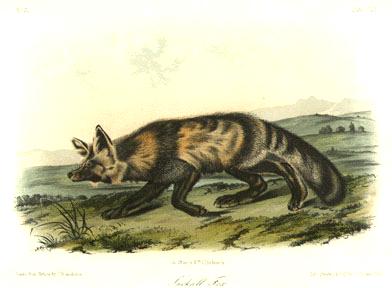

151 Jackall Fox
VULPES UTAH.--AUD. and BACH.
[Urocyon cinereoargenteus]
JACKALL FOX.
[Gray Fox]
PLATE CLI.
V. corpore grandiore, pilis velleris longioribus nec non gracilioribus quam
in V. fulvo, cauda magna cylindracea.
CHARACTERS
Larger than Vulpes fulvus; fur longer and finer than in that species; tail
large and cylindrical.
SYNONYMES.
VULPES UTAH.--Aud. and Bach., Proc. Acad. Nat. Sci., Phil., 1852, p. 114.
VULPES MACROURUS, Baird, Stansbury's Report.
DESCRIPTION.
Claws slightly arched, compressed, channelled beneath, horn color; hair, of
two kinds, first, a coarse and long hair covering the fur beneath it; second, a
dense and very soft fine fur, composed of hairs that are straight, but crimped
and wavy, as in the silver grey fox. Fur plumbeous at the roots, gradually
becoming dark brown towards the tips in those parts of the body which are dark
colored on the surface; in those parts which are white, the fur is white from
the roots, and on no part of the animal does it present any annulations.
The long hairs are dark-brown from the roots, yellowish-white near the
middle of their length, and are tipped with black.
On the under surface the hairs are principally white their whole extent,
with a few black ones intermixed; the fur on the tail is rather less fine and
more woolly than on the body.
Feet covered with soft hair reaching beyond the toes; on the forehead the
hair is rather coarse and short, with fine fur beneath.
COLOUR.
Greyish-white on the head, dark brown on the neck, greyish-brown on the
dorsal line and on the sides; the throat, under surface of the body, insides of
legs, and feet black.
The tail is irregularly banded with dark brown and dull white, the tip
white for about three inches.
Another Specimen.--Nose, both surfaces of the legs, and behind the ears,
dark, reddish-brown; whiskers black; under side of neck, and a line on the
belly, liver brown. Fur on the back very fine, and dark ashy-grey from the
roots: the longer hairs on the back are black at the roots, and are broadly
tipped with white; fur on the sides, cinereous at the roots, and yellowish-white
from thence to the end.
There is a reddish tinge on the neck, extending to the shoulders; sides of
the face grizzly-brown; the hair on the tail is irregularly clouded with brown
and dull white, and is lightest on the under surface.
DIMENSIONS.
Feet. Inches.
From point of nose to root of tail, . . . . 2 8
Tail, (vertebrae,). . . . . . . . . . 1 4
Tail (to end of hair,) . . . . . . . . 1 8
Circumference of tail, (broadest part,). . . 1 8
From shoulder to fore-feet,. . . . . . . 1 5
From rump to hind-feet, . . . . . . . . 1 6
Height of ears, (posteriorly,). . . . . . 0 4
From point of nose to eye, . . . . . . . 0 3 1/8
Longest hairs on the brush,. . . . . . . 0 5
Longest hairs on the body, . . . . . . . 0 3
HABITS.
This animal was first noticed, by LEWIS and CLARK, as the large Red Fox of
the plains, (vol. 2, p. 168,) and was referred to by us in the first volume of
the Quadrupeds of North America, p. 54, where we described it from a hunter's
skin.
Having obtained a beautiful specimen from Captain RHETT, of the United
States Army, we gave it the name of Vulpes Utah, as it is, so far as our
information extends, chiefly found in the Utah territory, although it probably
ranges considerably north of the Great Salt Lake.
The habits of this beautiful Fox are similar to those of the Red Fox, and
it runs into many varieties of color.
Captain RHETT informed us that he killed the specimen, kindly presented to
us by him, near Fort Laramie.
Several specimens of Vulpes Utah have been received at the Smithsonian
Institution, and it will probably soon be well known.
GEOGRAPHICAL DISTRIBUTION.
This Fox, as we have ascertained since writing the above, is procured
throughout the Rocky Mountain regions, although by no means abundantly, as far
north as the traders of the fur companies push their outposts. It is found also
in Oregon.
GENERAL REMARKS.
The exploring expedition sent by the United States, (1838 to 1842) did not
procure any specimens of this Fox, although we find by Mr. PEALE's Catalogue,
they obtained the Vulpes Virginianus, in both Oregon and California.
|